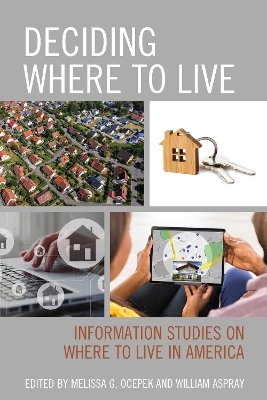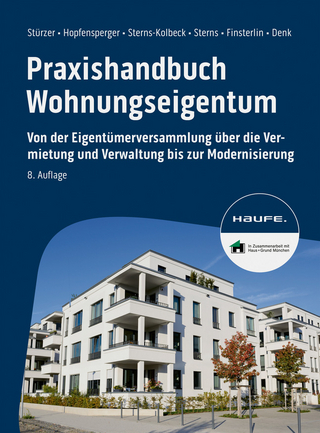
Deciding Where to Live
Rowman & Littlefield (Verlag)
978-1-5381-8360-1 (ISBN)
Deciding Where to Live: Information Studies on Where to Live in America explores major themes related to where to live in America, not only about the acquisition of a home but also the ways in which where one lives relates to one’s cultural identity. It shows how changes in media and information technology are shaping both our housing choices and our understanding of the meaning of personal place. The work is written using widely accessible language but supported by a strong academic foundation from information studies and other humanities and social science disciplines.
Chapters analyze everyday information behavior related to questions about where to live. The eleven major chapters are:
Chapter 1: Where to live as an information problem: three contemporary examples
Chapter 2: Turning in place: Real estate agents and the move from information custodians to information brokers
Chapter 3: The Evolving Residential Real Estate Information Ecosystem: The Rise of Zillow
Chapter 4: Privacy, Surveillance, and the “Smart Home”
Chapter 5: This Old House, Fixer Upper, and Better Homes & Gardens: The Housing Crisis and Media Sources
Chapter 6: A Community Responds to Growth: An Information Story About What Makes for a Good Place to Live."
Chapter 7: The Valley Between Us: The meta-hodology of racial segregation in Milwaukee, Wisconsin
Chapter 8: Modeling Hope: Boundary Objects and Design Patterns in a Heartland Heterotopia
Chapter 9: Home buying in Everyday Life: How Emotion and Time Pressure Shape High Stakes Deciders’ Information Behavior
Chapter 10: In Search of Home: Examining Information Seeking and Sources That Help African Americans Determine Where to Live
Chapter 11: Where to Live in Retirement: A Complex Information Problem
While the book is partly about the goal-directed activity of individuals who want to buy a house, and the infrastructure that supports that activity, it is also about personal activities that are either not goal directed or are directed at other goals such as deciding in which geographic location to live, personal entertainment, cultural understanding, or identity formation.
William Aspray is professor of information science and adjunct professor of media studies at the University of Colorado Boulder. He has formally taught at Harvard, Indiana (Bloomington), Penn, Rutgers (New Brunswick), Texas (Austin), Virginia Tech, and Williams. He has also served in senior management positions at the Charles Babbage Institute, Computing Research Association, and the IEEE History Center. He served as the editor in chief of Information & Culture: A Journal of History. His books in the information studies area include: Fake News Nation (with James Cortada, Rowman & Littlefield), From Urban Legends to Political Fact-checking (with James Cortada, Springer), Food in the Internet Age (with Melissa Ocepek and George Royer, Springer), Everyday Information (ed., with Barbara Hayes, MIT Press), Digital Media (ed., with Megan Winget, Scarecrow), and Privacy in America (ed., with Philip Doty, Scarecrow). Melissa G. Ocepek is an Assistant Professor at the University of Illinois Urbana-Champaign in the School of Information Sciences. Her research draws on ethnographic methods and institutional ethnography to explore how individuals use information in their everyday lives. Her research interests include everyday information behavior, critical theory, and food. Dr. Ocepek has published two books that address the intersection of food, information, and culture: Food in the Internet Age and Formal and Informal Approaches to Food Policy (both with William Aspray and George Royer). Dr. Ocepek received her Ph.D. at the University of Texas at Austin in the School of Information.
Preface
Chapter 1: Where to live as an information problem: three contemporary examples - William Aspray and Melissa G. Ocepek
Chapter 2: Turning in place: Real estate agents and the move from information custodians to information brokers – Steve Sawyer
Chapter 3: The Evolving Residential Real Estate Information Ecosystem: The Rise of Zillow - James W. Cortada
Chapter 4: Privacy, Surveillance, and the “Smart Home” - Philip Doty
Chapter 5: This Old House, Fixer Upper, and Better Homes & Gardens: The Housing Crisis and Media Sources - Melissa G. Ocepek
Chapter 6: A Community Responds to Growth: An Information Story About What Makes for a Good Place to Live." - Hannah Weber, Vaughan Nagy, Janghee Cho, and William Aspray
Chapter 7: The Valley Between Us: The meta-hodology of racial segregation in Milwaukee, Wisconsin - Judith Pintar
Chapter 8: Modeling Hope: Boundary Objects and Design Patterns in a Heartland Heterotopia- David Hopping
Chapter 9: Home buying in Everyday Life: How Emotion and Time Pressure Shape High Stakes Deciders’ Information Behavior - Carol F. Landry
Chapter 10: In Search of Home: Examining Information Seeking and Sources That Help African Americans Determine Where to Live - Jamillah R. Gabriel
Chapter 11: Where to Live in Retirement: A Complex Information Problem- William Aspray
Chapter 12: Closing Statement
About the Editors and Contributors
| Erscheinungsdatum | 20.04.2023 |
|---|---|
| Verlagsort | Lanham, MD |
| Sprache | englisch |
| Maße | 151 x 229 mm |
| Gewicht | 503 g |
| Themenwelt | Sozialwissenschaften ► Kommunikation / Medien ► Buchhandel / Bibliothekswesen |
| Wirtschaft ► Betriebswirtschaft / Management ► Rechnungswesen / Bilanzen | |
| Betriebswirtschaft / Management ► Spezielle Betriebswirtschaftslehre ► Immobilienwirtschaft | |
| Wirtschaft ► Betriebswirtschaft / Management ► Unternehmensführung / Management | |
| ISBN-10 | 1-5381-8360-9 / 1538183609 |
| ISBN-13 | 978-1-5381-8360-1 / 9781538183601 |
| Zustand | Neuware |
| Haben Sie eine Frage zum Produkt? |
aus dem Bereich


